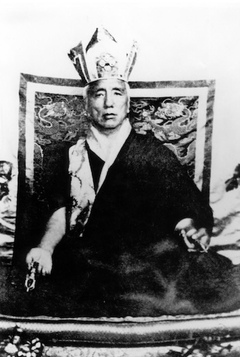Heart Advice in a Nutshell
Literary Genres › Advice | Tibetan Masters › Jamyang Khyentse Chökyi Lodrö

Jamyang Khyentse Chökyi Lodrö
Photographer unknown
Further information:
Heart Advice in a Nutshell
by Jamyang Khyentse Chökyi Lodrö
Homage to the incomparable source of refuge, the Precious Lord of Oḍḍiyāna!
This excellent support, a human form with its freedoms and advantages,
Is so difficult to obtain; but now that we have actually gained one,
Let us strive to make it meaningful and realize its full potential,
Without squandering the opportunity and letting it go to waste.
The root of all dharmas is one's own mind:
Convincing when unexamined, ingenious in its deception;
Yet, when investigated, without basis or origin;
In essence, free of coming, staying or going.
All the phenomena of saṃsāra and nirvāṇa
Are but pure or impure projections of one's own mind.
In reality, neither saṃsāra nor nirvāṇa exists.
Empty from the very beginning, pure from the first —
Still, this emptiness is not a nihilistic void,
For there is spontaneous presence in the nature of clear light.
Responsive pure awareness is the basis for all that unfolds.
Rigpa is beyond designation and verbalization.
From its potential saṃsāra and nirvāṇa arise in all their multiplicity.
The manifestation and the one that brings it about are not two:
In the experience of this non-duality, remain—unaltered.
Let your body settle, without moving about or fidgeting.
Let your speech settle, following the flow of the breath.
Let your mind settle, without pursuing thoughts or ideas.
Spaciously, from deep within, settle and relax in natural ease.
Pure awareness of the unborn dharmakāya
Is not created by cause or condition, but is naturally occurring.
Vividly alert, fresh and nakedly clear,
Unstained by thoughts of perceiver or perceived,
Unspoiled by presumptive understanding—
In this natural experience of concentration, remain.
‘Remain’, however, is but an expression —
In reality, there is no one that remains, nor any remaining as such.
In this rigpa-emptiness—the dharmakāya’s very own face —
Abide at all times, in undistracted recognition.
There’s no end to the activity and delusions of saṃsāra:
The more you do, the more they go on increasing,
Animosity and attachment strengthen all the while,
Creating the causes for your own downfall.
Turn your mind, therefore, towards the Dharma.
If you can integrate the Dharma physically, verbally and mentally,
You have set out on the path to liberation and enlightenment,
And, at the moment of death, you will have no regrets.
In this and all your future lives,
You will go from one joy to the next.
Visualize the one who is most kind and gracious,
Your own guru, inseparable from the Great Orgyen,
At the crown of your head or in your heart.
And generate fervent, longing devotion.
Whatever happens, good or bad, happiness or sorrow,
Pray to your precious fatherly guru.
Blend your own mind indivisibly with his, and rest.
At the moment of death, abandon attachment and aversion,
Visualize the precious Guru of Orgyen at your crown.
And dissolve your consciousness, an orb of light symbolized by HRīḤ (ཧྲཱིཿ),
Into the great, glorious Orgyen’s heart-centre.
If you practise this regularly from now on,
It will come readily at the time of death.
Recite the aspiration of the Glorious Copper-Coloured Mountain, too.
In conclusion, Dharma practice is:
To cut attachment to saṃsāra,
To generate love and compassion for beings of the six classes,
And to tame completely this mind of ours.
Practise this all the time, I beg you, without distraction!
Even though I lack any practice myself,
This short advice,
Which accords with the words of the great saints of the past,
Was written by the stubborn Dharmaless parasite,
The one called Chökyi Lodrö,
For the noble bhikṣunī Pelu,
Simply to avoid turning down her request.
Sarva maṅgalam.
| Translated by Adam Pearcey, 2017, with many borrowings — including the title — from the 1981 version by Rigpa Translations.
Bibliography
Tibetan Editions
'Jam dbyangs chos kyi blo gros. "gdams ngag gnad dril" in gsung thor bu/_'jam dbyangs chos kyi blo gros/ (rgya gar bir'i par ma/). BDRC W21814. 2 vols. null: null, null. Vol. 2: 67–70
_____ . "gdams ngag gnad dril" in gsung 'bum/_'jam dbyangs chos kyi blo gros/ (dbu med/). BDRC W21813. 8 vols. Gangtok: Dzongsar Khyentse Labrang, 1981–1985. Vol. 2: 351–354
_____ . "gdams ngag gnad dril" in ’Jam dbyangs chos kyi blo gros kyi gsung ’bum. 12 vols. Bir: Khyentse Labrang, 2012. BDRC W1KG12986 Vol. 8: 249–252
Version: 1.4-20230414